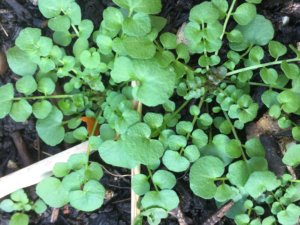
For a small, low growing and rather unassuming plant, Hairy Bittercress has quite a bit going for it. It has the welcome habit of bringing wild food right to your back door as it often grows as a garden weed, springing up in flower pots, the gaps between paving slabs or around the edges of flower beds. It is available for most of the year, emerging in early spring and seeding itself right through into the winter if conditions remain mild, though it is often at its best earlier in the season.
It doesn’t entirely live up to its name in that it’s not especially hairy and it doesn’t taste bitter, though the cress part, at least, is spot on. You can use it in salads or in sandwiches and I find it a great fall-back for days when I haven’t been able to get out into the field; I can wander into the garden at lunchtime and brighten up a cheese sandwich with a sprinkling of leaves. I was delighted to find it last week in the grounds of my daughter’s accommodation at the University of Sheffield. She and her flatmates seem to subsist mainly on pizza but at least now they will be able to add a few bittercress leaves to top up their vitamin C levels.
The elongated seed pods (when present) are also edible, though the tiny seeds are eaten by small finches and other species, so leave some in place if you want to attract more birds to your garden. There are a few similar but less common bittercresses and the well-known Cuckooflower (or Lady’s Smock) is also part of the same group. All are edible and have varying degrees of spiciness so feel free to experiment.
[registration_form]